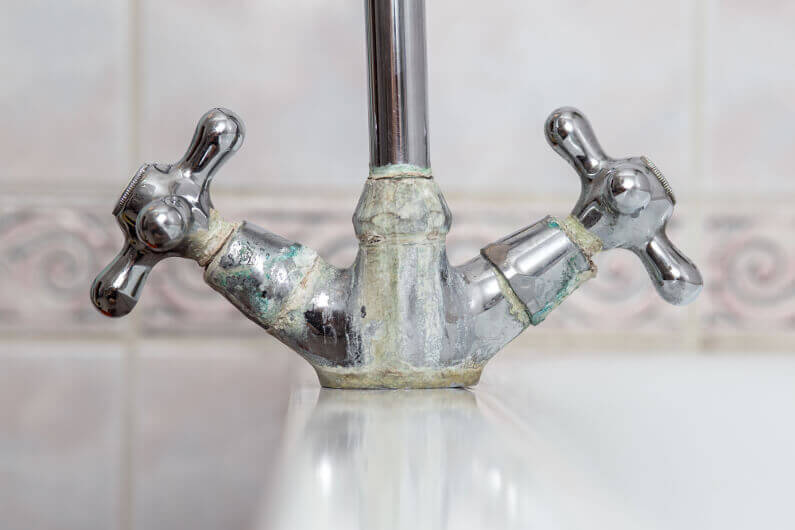John the Plumber's Blog
Plumbing Articles from Kansas City, MO & KS
How to Remove Calcium Buildup in Pipes: Everything You Need to Know

Nothing is more frustrating than a toilet, sink, or drain that doesn’t work right. Even if they eventually get the job done, sluggish pipes can be an annoyance for most homeowners. And, the truth is, they’re pretty common.
If you didn’t know, your water contains minerals. Minerals that are passing through your pipes every single day. The products we use like dish detergent, shampoo, conditioner, and other cleaners, also leave stuff behind as they pass through your pipes.
Over time, minerals like calcium can build up in your pipes. Today, we’re going to talk about how to remove calcium buildup in pipes. And, we’re going to talk about how to remove it for good.
Too many solutions work for a short period of time. Then, the calcium buildup slowly creeps back in. We’re going to cover what calcium build-up is, what white build-up in a drain pipe is, and what dissolves calcium build-up in drains.
We have a lot of information to cover. Let’s get going
What Is Calcium Build Up?
Calcium buildup in drains tends to be more common in areas where they have “hard water“. This term refers to water with higher mineral content than other areas in the country. Two examples are Kansas City, MO, and Florida.
If you don’t take any steps to alleviate calcium build up it can severely clog your drains. This can eventually lead to much more serious plumbing issues.
The white build-up is similar to the calcium build-up. It’s a white “gunk” that builds up in your shower, and other plumbing drains. White build-up gets its name because it contains more lime and magnesium. These are two other popular minerals in local tap water sources.
Signs of Calcium Build Up In A Drain
The key to getting rid of calcium buildup for good is to catch it early. The best way to do that is to be knowledgeable about the signs of symptoms of calcium buildup.
One of the most obvious symptoms is clogged drains. If water starts to flush or go down other drains more slowly, it may be a sign of calcium buildup in a shower or drain.
Another tell-tale sign of calcium buildup is damage to an appliance or plumbing fixture. If you start to see a white build-up around a showerhead, shower drain, or faucet, it could be a sign you have hard water or experiencing a mineral build-up issue.
Some more indirect signs that are an indication you have hard water are skin irritation when showering and difficulty cleaning clothes. If you’re in an area that has hard water, you’ll have some difficulty creating a lather with soaps or detergents.
The extra minerals in the water may also irritate the skin.
Finally, soap scum, spots, and streaks on dishes, high water heater energy use, and lime scales are all other possible indications of mineral build-up or hard water.
Lime scales are hard, white deposits of “gunk” left behind where hard water runs or drains.
How To Remove Calcium Build Up In Pipes
If you’re experiencing problems with your drains, we’d like to show you a quick method of how to remove calcium buildup in pipes.
First, we’re going to need a few things. You’ll need to get the following items.
- A pot of water
- A rag
- A sponge
- 1/2 cup of baking soda
- 1/2 cup of vinegar
The first step is to boil the pot of water. Next, pour your half cup of vinegar and baking soda down the drain. Third, put your rag over the top of the drain.
Now, you’re going to want to wait about five minutes. This is so the mixture of baking soda and vinegar can eat away the buildup clogging the drain. Then, you can go ahead and pour the boiling water down the drain.
Once the boiling water reacts with the vinegar and baking soda the gunk should break apart. Normally, once is enough to break up most mineral deposits. If you have a particularly stubborn clog, you may want to do it a few times.
How To Remove Build Up In A Showerhead
The process is a little different when you’re cleaning out a showerhead. You’re going to need a few more tools. You’ll need a wrench, pliers, rags, vinegar, and a plastic bag or container.
Wrap your showerhead with your rag. This is to protect the decorative finish from damage from the wrench or pliers. Next, unscrew the showerhead with your wrench and pliers.
Once the showerhead is apart, soak the pieces in a “vinegar bath”. This is just your vinegar poured into your plastic bag or plastic container.
Soak the showerhead in your vinegar bath overnight. Once enough time has gone by, rinse the showerhead with water. Then, just reassemble your showerhead and you should be good to go.
Hire A Plumbing Professional
Some drain clogs can be pretty stubborn. If this is the case, you may want to consider hiring a plumbing professional. When the typical DIY solutions don’t work, they can provide a more heavy-duty solution.
It’s also a good idea to consult a professional if you’re unsure about the cause of your problem. Most of the time it’s just mineral build-up. The DIY method above can be an easy solution for that.
But, some major plumbing problems show the same signs and symptoms as the mineral build-up. It’s important to be sure of what you’re dealing with before you’re in over your head.
The Drainage Doctor Is In
There you have it! Now you know everything there is to know on how to remove calcium buildup in pipes and showerheads. You have most of the tools necessary to solve the problem right there in your kitchen.
If the problem persists, try the DIY solution we gave you a few more times. If the drain or showerhead is still giving you problems, call a professional.
If you’re in the Kansas City, MO area, the team at John The Plumber can help. Contact us today. We’ll answer any questions you have and make an appointment to come out and help you right away.
We do whatever it takes to make our customers happy. We look forward to hearing from you soon!
7 Comments
Submit a Comment
Request Free Quote
Serving Kansas City, Overland Park, Independence, Shawnee, & Surrounding Area's
FREE ESTIMATES
john the plumber
Full Service Plumbing Kansas City, MO-KS
John the Plumber LLC
5963 Paseo Blvd.
Kansas City, MO 64110
(816) 708-2020
or Send Us an Email Here.
© 2017-2024 JohnthePlumberKansasCity.com
– All rights reserved. –
Information on this website may not be re-used without prior written consent from John the Plumber LLC.
HOURS & LICENSE INFO
Monday-Saturday: 8:00am to 8:00pm
Sunday: Closed Normal Appointments
Emergency Client Service Available
Kansas & Missouri Licensed, Bonded, Insured
Master Plumbing Contractor 204249





How do you get the calcium out of the pipes coming into the house (or motorhome in my case). These instructions are great but it looks as if it only helps on the drain pipes and the shower heads, etc. Am I looking at this wrong?
My water supply lines to different faucets and toilets are completly closed off with calcium, how do i unclog them ? I have tried C.L.R but that seems to do nothing, please help, thank you
This process is for cleaning out drain lines, correct?
I’m thinking my slow flow in our tub/shower is caused by calcium/magnesium in the SUPPLY copper lines. They are 50 years old and we have well water.
What is the process for cleaning SUPPLY lines?
plumber says shower line has calcium build up causing low pressure , says vinegar will break down calcium
however, pipe is over head ,problem how to get vinegar in pipe , he thinks he can pump vinegar into line, but never came back. how can i get vinegar into pipe, it goes up 1 foot and then laterally about 4 feet to valve
Did anyone ever answer you on this? I am having an issue with 2 bathroom faucets with a gooseneck. The aerator is clean but I think the slow flow is from buildup in the neck itself. I do not want to replace them if I don’t have to.
How to get Kelsy built up how old are the waterlines throughout the house
How to get calcium build up in waterlines throughout the whole house